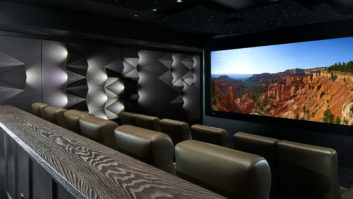Once in a while, when someone thinks that I have said something outrageous (don’t worry, that NEVER happens), the people I am conversing with will say something along the lines of “Are you REAL?” Yes, I assure them, I am indeed real and most often meant what I had just said. When you look around, unless you are in a mirage, the people listening are also real. Even in a videoconference, unless it is one of those spy movies where the person you think is there is actually pre-recorded, it is 99 percent certain that the folks in those video windows are real.
Sticking with movies and TV shows for a minute, we’ve all seen things such as Star Trek’s “Holodeck” and the like. However, as we move into a world where entertainment is presented in many different forms, reality is changing. And, dear readers, that is something you will need to change with as well.
What we now call “virtual reality” has been around for over 60 years. As far back as 1961, Morton Heilig patented the “Sensorama Simulator” where the patent states the goal to “…stimulate the senses of an individual to stimulate an actual experience realistically.” Then, in 1968, Ivan Sutherland, widely regarded as “the father of computer graphics” and later the co-founder of Evans and Sutherland, a major force in simulation, created the first head-mounted VR/AR display along with his University of Utah student Bob Sproull. Using two CRTs in a somewhat crude binocular display, it required what was then a major-sized computer and was so heavy that it couldn’t be worn on the user’s head.
Suffice to say, technology has advanced since Sutherland’s “Sword of Damocles.” We now have a variety of compact, lightweight headsets and the computing power of a smartphone, itself unimaginable in those early days. Perhaps more importantly, there is a growing range of commercially available software in a variety of formats, for a wide range of viewing devices, and across many content areas – from instructional and training to entertainment and 360-degree presentation of live content.
However, for all those advances, there are still many aspects of what is variously known as virtual reality (VR), augmented reality (AR), mixed reality (MR), and even merged augmented-virtual reality (let’s call that MAVR) that many find confusing. To make things clear to all, and particularly by extension to your prospects, clients, and customers, this space is devoted to clearing the air on this – in reality, not virtually.
Virtual Reality
Since some of your clients may mash these forms together, let’s start with virtual reality (VR). VR is the presentation of an image displayed via a headset or similar device that, to the best of its ability, totally blocks out the surrounding environment around the viewer. In most cases, but not all, the images presented are computer generated. In some cases, however, they include live or recorded video of real-world video mixed in. Sound is typically through headsets and, when tied to video games, the control is done with a variety of controller form factors. Advanced systems may also use position sensing in the headset or, for things such as training and simulation, additional options such as a gun, baseball bat, or even a fire hose and a vest that heats up to simulate proximity to the fire.
Where the visual input is from live, 360-degree imaging, one still uses the headset, but positioning sensing lets you turn your head to see different perspectives with content from the likes of the New York Times, or to “look around the stadium” from the perspective of any player. Call this use of “real-world” video shown in an immersive setting “hybrid VR.”
So far, so good. However, there are some drawbacks to the use of totally immersive headsets, particularly nausea when the content involves fast motion or, for those who are acrophobic, views from virtual tall buildings. Headsets and their associated computing can range from well over $1000 for “pro” systems with all the bells and whistles, to the $200 to $300-ish range for self-contained systems such as Sony PlayStation VR and the new Oculus Go. VR on the cheap? A Google Daydream is under $100 and a Google Cardboard can be anywhere from around $10 to free when you get one as part of an advertising promotion.
Augmented Reality
If the totally immersive nature of VR doesn’t work, the alternative approach that is gaining wide interest is augmented reality (AR), also known in some quarters as mixed reality (MR). Using open glasses with a built-in display or simply viewed on a smartphone or tablet held in front of the viewer/participant, AR eliminates the enclosed environment of VR and does not block out the outside world.
Indeed, AR depends on being able to see one’s surroundings as it is based on placing generated, virtual objects in/over the real-world view with sensory cues that are consistent with the physical world. In other words, you see what is real and, through the manipulation of the program or app, you see “unreal” objects placed in your field of view.
Perhaps the best-known example of AR to date is “Pokemon Go.” One loads the program, scans a scene, and then you see computer-generated objects dropped in. As you point the phone with its camera and position sensing, the view changes and the objects react accordingly. Using the touchscreen, you can throw objects that are key to the game.
Of course, AR is much more than games. Being able to place artificial objects in real-world environments is perfect for education and training. With VR, you only see the scenario presented by the system. With AR, one can see an object, move around it to get a different view, and then see relevant information. For example, imagine a quality control inspector looking at an engine, moving around to view it from different angles, and then seeing the CAD view of the part numbers or inner workings superimposed. Based on conversations with manufacturers at ISE in February, those types of uses are already in place on the factory floor of a major automotive manufacturer.
It always helps to speed the acceptance of a technology when a major company gets behind it. VR has Facebook’s Oculus, Samsung’s Gear VR, Google’s Cardboard and Daydream, Sony’s PlayStation VR, HTC’s Vive, and others behind it. AR has major proponents in Microsoft for its Hololens, which uses a glasses-like viewer, and Apple’s ARKit, which uses a phone or tablet rather than a head-worn viewing device. Given the market power and development community behind Apple, the recently announced ARKit 2 is certain to spike interest in, and availability of, AR content.
Merged Reality
Although not as familiar to the public at this point, there is another version of this concept to be on the look out for. As described by Dr. Achin Bhowmik, CTO of Starkey Hearing Technologies, one of the world’s largest hearing aid companies, in a presentation at SID Display Week back in May, there is a third combination of “real” and “virtual” reality – what he called “merged reality” or “augmented-virtual reality” (A-VR) – turns AR inside out.
With this technology, rather than seeing CGI objects imposed over the real world, A-VR blends real-world elements into a virtual environment. Keeping consistent perceptual cues and reaction to natural human interaction, this will let a player put their own image into a CGI or other pre-recorded environment and have the content react to the user’s actions. Picture, perhaps, a first-person shooter game where the characters in the artificial environment are not avatars, but real-life video of the players. Still at a nascent stage, this also has interesting possibilities for training, role-playing. and, of course, entertainment.
What It All Means
Now that you have the background on the various flavors of VR, AR, and A-V R, what does this mean to your everyday world of reality, how can you help provision it, and what is moving up over the horizon?
Of course, the first question is: “How can I make money on all of this?” other than the obvious sale of headsets, computers, and games. Perhaps obvious but worth mentioning, all of these, particularly computer-based VR, depend on low-latency. Is the broadband network in the home up to the demands of gamers? If not, there is an easy opportunity to suggest a network upgrade. While AR is more wireless based, in many cases VR is best suited to hard-wired connections. In a market where everyone thinks wireless, this is an opportunity to possibly suggest cabled connections.
For hardcore VR gamers, previous CES and E3 shows have shown many different accessories – including things that are exotic such as pressure-pad and treadmill-like bases – but other than weapon-type devices, that seems to have diminished in popularity based on June’s E3 event. As haptics becomes more prevalent, one accessory option may be wearable products such as CaptoGlove, which is worn on the hands and lets the user control action by finger movement, eliminating the need for controllers.
While anything with a headset display or glasses tends to focus attention on video, when it comes to VR or AR, don’t forget audio. Particularly for the totally immersive, controlled world of VR, headsets are critical and tend to be the desired audio pay-out product. While some of the devices come with standard or optional manufacturer-supplied headsets, more capable headphones greatly add to the experience.
Some of the more game-oriented brands such as Turtle Beach, Logitech’s Astro Gaming line, and Plantronics have models better suited to VR than what you may find at a can-jam. Look for a headset that fits properly in conjunction with the VR device without getting in the way. Also look for closed, over-ear ear pieces that further the immersion by blocking outside sound. Also look for products such as the Astro or Plantronics models that include mixers, audio controllers, or, in the case of some Plantronics Rig models, include Dolby Atmos sound.
A final note on audio headsets for VR and other gaming, while most console and PC multi-player games use voice chat, some VR adventures do not. Most of the better gaming headsets feature removeable mic booms, which allows them to be removed when not needed.
Before leaving the subject, it is important to mention that all of these technologies may actually have an important place in your business as a sales tool. VR applications exist that provide a virtual blank canvas set to the measurements of a client’s room. The prospect may then place virtual objects representing furniture, flat panel or projection screens, speakers, and other home or theater products into the job. With AR, products from manufacturers have enabled the viewer to place a flat panel display into a real-world image. Look for more of these types of products to become available this year.
What’s Next?
Hopefully this has given you a mini-tutorial on what VR/AR/A-V R is today. Where will we be going forward? One possible advancement will be multi-focal VR, as described by Dr. Douglas Lanman of Oculus Research at Display Week. Rather than have a “flat” display, eye-tracking and other technologies will make it possible to have true variable depth of field for VR.
On the AR side, Apple’s announcement of ARKit 2 will open the door to easier creation of your own AR content. That may be a key facilitator to broaden awareness and use of AR.
At the end of the day, these technologies are more than just “games.” The possibilities are many for your business. Hopefully with this mini-tutorial you will be better able to explain the jargon to your customer base and find ways to monetize it to accelerate the growth of your business.







